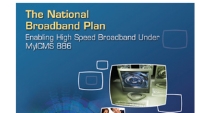Broadband plan delivered to Congress; let the spin begin

Last week, and after much negotiation between the various entities involved, the FCC finally delivered its 376-page National Broadband Plan to Congress. Now the spin on all sides has begun.
In some ways, the conflicting reactions were predictable. Telecommunications companies are worried that new regulations might impede Internet access expansion. Industry analysts said the plan was both too ambitious and not detailed enough, and consumer advocates doubted it alone would lead to more affordable broadband service at adequate speeds.
But, by and large, all of the competing parties promised to participate and work with the FCC and Congress as they grapple with the tough issues ahead.
The FCC’s broadband plan proposes to allot more wireless spectrum for mobile devices, redirect some subsidies toward broadband access, develop a nationwide network for emergency first responders and create a “digital literacy corps” to train new users.
The plan predicts that by 2020 at least 100 million households will have access to Internet service running at 100Mb/s, and community institutions like schools and hospitals will have access at 10 times that speed. Today, the average at-home connection is 3Mb/s-4Mb/s now, a speed too slow to deliver increasing rich multimedia content.
Broadband expansion was a major component of President Obama’s presidential campaign in 2008. The president said the plan recalled the way “past generations of Americans met the great infrastructure challenges of the day, such as building the transcontinental railroad and the Interstate highways.” With the United States falling behind in broadband access, the plan is positioned as central to the continued growth of the infrastructure of the United States.
For television broadcasters, widely perceived to be losers in the plan, attention centered on one word: voluntary. The FCC is relying on broadcasters to “voluntarily” give up some of their spectrum so it can be used for broadband services. The broadcasters, though they paid nothing for the spectrum in the first place, would be allowed to share proceeds from the auction of their airwaves.
Get the TV Tech Newsletter
The professional video industry's #1 source for news, trends and product and tech information. Sign up below.
The broadcasters have the choice to participate or not, but worry that the government might force them to give up spectrum if they don’t go along. The NAB, the broadcaster’s chief lobbyist, was muted in its response to introduction of the plan.
“We were pleased by initial indications from FCC members that any spectrum reallocation would be voluntary, and we’re therefore prepared to move forward in a constructive fashion on that basis,” said Dennis Wharton, the NAB spokesman. “However, we are concerned by reports that suggest many aspects of the plan may in fact not be as voluntary as originally promised. Moreover, as the nation’s only communications service that is free, local and ubiquitous, we would oppose any attempt to impose onerous new spectrum fees on broadcasters.”
Craig Moffett, a telecommunications industry analyst with Sanford C. Bernstein & Company, said the broadband plan “sets up a hundred different battles over funding and spectrum and even set-top box design, and each on its own would represent an ambitious agenda.”
Moffett’s analysis seemed to be shared by many. The battles over broadband in the months ahead will determine whether or not it is successful.
“The real test begins now, and the final grade will depend on the commission’s execution of future proceedings that will be required to transform the national broadband plan into reality,” said Andrew Schwartzman, president of Media Access Project, a public interest group.
The entire National Broadband Plan document can be read online.
